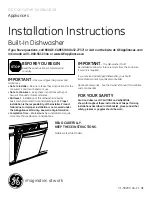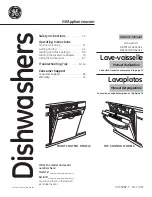
28
Solutions to Common Problems
Common Washing Problems
Many washing problems involve poor soil and stain removal, residues of lint and scum, and fabric damage.
For satisfactory washing results, follow these suggestions provided by The Soap and Detergent Association.
PROBLEM
POSSIBLE CAUSES
SOLUTIONS
PREVENTIVE MEASURES
Blue stains
Undiluted liquid detergent
•
or fabric softener dispensed
directly onto fabric.
If caused by detergent, mix 1
•
cup (240 ml) white vinegar with
1 quart (.95 L) water in a plastic
container. Soak item 1 hour.
Rinse.
If caused by fabric softener, rub
•
stains with bar soap. Wash.
Avoid overfi lling detergent
•
and fabric softener com-
partments of dispenser.
Discoloration,
graying
Not enough detergent.
•
Wash water temperature too
•
low.
Incorrect sorting.
•
Rewash with correct amount of
•
detergent and hottest water safe
for fabric.
Add bleach safe for fabric.
•
Sort items by soil level and
•
color.
Use correct amount of de-
•
tergent, hottest water and
bleach safe for fabric.
Greasy, oily
stains
Not enough detergent.
•
Undiluted liquid fabric
•
softener poured directly on
fabric.
Treat with prewash stain remover
•
or liquid detergent.
Increase detergent and water
•
temperature. Rewash.
Rub fabric softener stains with
•
bar soap.
Use correct amount of
•
detergent and hottest water
safe for fabric.
Do not pour liquid fabric
•
softener directly on fabric.
See Operating Your, step 5.
Holes, tears,
or snags
Incorrect use of chlorine
•
bleach.
Unfastened zippers, hooks,
•
buckles.
Rips, tears and broken threads.
•
Overloading the washer.
•
Degradation of fabric.
•
May be irreversible if rips, tears
•
and seams cannot be mended.
Never pour chlorine bleach
•
directly on fabric.
Check condition of items
•
before washing. See Oper-
ating Your, steps 2 and 5.
Lint
Incorrect sorting.
•
Tissues left in pocket.
•
Overloading the washer.
•
Not enough detergent.
•
Undissolved detergent has
•
left a residue resembling lint.
Static cling is attracting lint.
•
Load washed too long.
•
Reduce load size. Rewash using
•
correct water temperature, water
level, and amount of detergent.
Add nonprecipitating water con-
•
ditioner to wash water to remove
detergent residue.
Add liquid fabric softener to fi nal
•
rinse.
Dry load in dryer.
•
Remove lint with lint brush or
•
roller.
See Operating Your, steps
•
1 and 2.
Do not overload washer.
•
Use correct temperature
•
and amount of detergent,
water and wash time.
Pilling
(Fibers ball
up and cling
to fabric.)
Pilling is normal with syn-
•
thetic and permanent press
fabrics. This is due to abra-
sion from normal wear.
Use a lint brush or shaver to
•
remove pills.
Use fabric softener in the
•
washer to lubricate fi bers.
When ironing, use spray
•
starch or fabric fi nish on
collars and cuffs.
Turn items inside out to
•
reduce abrasion.
Residue or
powder on
dark items;
Stiff, harsh
fabrics.
Undissolved detergent.
•
Some granular detergents
•
can combine with hard
water minerals to form a
residue.
Overloading the washer.
•
Rewash load.
•
Increase water temperature us-
•
ing hottest water safe for fabric.
Do not overload washer.
•
Use liquid detergent or use
•
nonprecipitating water condi-
tioner with powder detergent.
Wrinkling
Overloading the washer.
•
Incorrect wash cycle for
•
wash load.
Reduce load size.
•
Rinse in cold water with liquid
•
fabric softener using the
casual
or
delicate
cycle.
Do not overload washer.
•
Remove items from washer
•
as soon as cycle is com-
pleted.
Use liquid fabric softener.
•





































